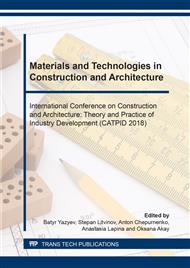p.30
p.36
p.42
p.47
p.54
p.60
p.66
p.72
p.78
Structural Concepts of High-Rise Buildings Resistant to Progressive Collapse
Abstract:
In the article there will be a consideration of collapse process progressive simulation of a high-rise building by removing the first-floor columns. The object of the study will be a 27-storeyed high-rise building. The high-rise building structural concept will consist on a monolithic reinforced concrete frame. The mounting base structural concept has been modeled as absolutely rigid. Static and dynamic calculations have been performed in the «Ing +» software complex, while the wind load pulsating component was taking into account using the finite-element method for the spatial slab-and-rod model. The dynamic calculation analysis has shown the obtained oscillation forms corresponding to the design requirements. The stress-strain behavior has been studied for the floor slabs as reinforce constructive of a typical floor. Structural concepts for the building frame of a high-rise building have been developed to reduce the progressive collapse risk. In the physically non-linear calculations, with the removal of the first-floor corner and central columns, four options for the sandwich floor slabs reinforcing were taking into account. The rational reinforcement option has been selected, in which the building is resistant to progressive collapse. The building frame structural concept with the floor slabs heavy-duty reinforcement of the first five floors has been suggested. An outrigger floor with encircling reinforced concrete trusses along the outer contour was included to reinforce the load-carrying framework. Recommendations on the choice of rational structural concepts, reducing a high-rise building progressive collapse risk have been given.
Info:
Periodical:
Pages:
54-59
Citation:
Online since:
September 2018
Keywords:
Price:
Сopyright:
© 2018 Trans Tech Publications Ltd. All Rights Reserved
Share:
Citation:


